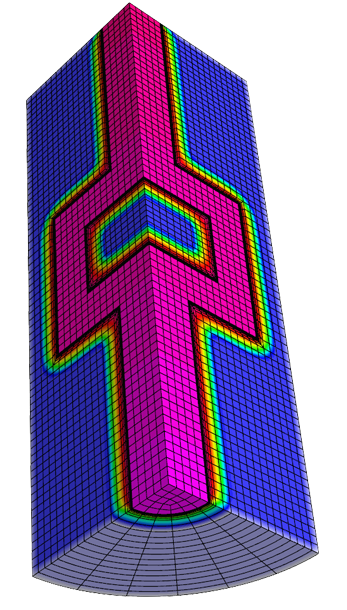Charles Still (14-SI-002)
Abstract
Simulation via high-performance computing is an essential cross-cutting capability of the Laboratory. Most multiphysics simulation tools were developed in an era when floating-point operations were the performance-limiting factor. However, data motion and memory capacity are now the limiting factors because energy considerations are driving the design of high-performance computing architectures. This effectively inverts the computing model used for the design of many current codes. We plan to establish a new breed of multiphysics simulation capabilities based on high-order finite-element formulations, where algorithms are designed from inception to take advantage of future hardware features. This will be accomplished by developing coupled high-order, finite-element numerical methods for multiphysics simulations involving arbitrary Lagrangian–Eulerian hydrodynamics (a mathematical description of fluid flow in a shocked substance), multigroup radiation-diffusion, and magneto-hydrodynamics. The numerical algorithm development will be complemented with a computer science research effort to show that high-order simulation technology is scalable, well-suited to advanced extreme-scale architectures, and offers multiphysics modeling capabilities superior to current algorithms.
If successful, we expect to deliver new high-order multiphysics algorithms, together with a prototype implementation that obtains high performance on multiple disparate advanced architectures as a proof of principle. Once proven, the concepts, methodologies, and many of the computational techniques can be extended to apply to diverse science and engineering areas. Our ultimate goal is to establish the mathematical and computer science research foundation for a new breed of multiphysics codes, well-suited to emerging architectures, which will expand the state of the art in high-fidelity modeling. This effort will continue the long history of LLNL leadership in the development of world-class simulation technology.
Mission Relevance
Developing improved multiphysics codes are central to the Laboratory's strategic focus area in stockpile stewardship science. Our goal is to demonstrate a new simulation capability—a scalable high-order, coupled multiphysics simulation—through development of a performance-portable code designed to work well on emerging advanced architectures that will form the basis for the technology platforms of LLNL's Advanced Simulation and Computing. Our research will provide a strong base in building an exascale (1,000-petaflop operating system) computing initiative, and supports the core competency in high-performance computing, simulation, and data science to simulate the behavior and performance of complex systems and expanding capabilities to exascale computing and beyond.
FY15 Accomplishments and Results
In FY15 we (1) completed, implemented (in the BLAST high-order finite-element hydrodynamics software), and demonstrated the capability of the high-order, multiple-material arbitrary Lagrangian–Eulerian algorithm; (2) developed and implemented a high-order closure model for sub-cell resolution without interface reconstruction; (3) proposed a high-order finite-element numerical method for multigroup diffusion; (4) developed a performance model and assessment for Lagrangian hydrodynamics; (5) incorporated algorithmic and performance optimizations based on the model (including static condensation, partial assembly, and stationary linear iteration) and demonstrated substantially improved performance with acceptable accuracy and robustness; and (6) delivered the high-order multiple-material arbitrary Lagrangian–Eulerian algorithm on multicore central processing units for further development.
Publications and Presentations
- Brunner, T. A., et al., High-order finite element Lagrangian hydrodynamics with radiation diffusion. (2015). LLNL-PRES-670726.
- Brunner, T. A., Preserving positivity of solutions to the diffusion equation for higher-order finite elements in under-resolved regions. Joint Intl. Conf. Mathematics and Computation (M&C), Supercomputing in Nuclear Applications (SNA) and the Monte Carlo (MC) Method, Nashville, TN, Apr. 19–23, 2015. LLNL-PROC-666744.
- Brunner, T. A., Preserving solution positivity of higher-order finite elements in under-resolved regions. (2015). LLNL-POST-669774.
- Dobrev, V. A. et al., Multi-material remap algorithms for high-order ALE simulations. (2015). LLNL-PRES-676869.
- Dobrev, V. A., et al., Multi-material remap algorithms for high-order ALE simulations. (2015). LLNL-PRES-675172.
- Dobrev, V., et al., Scalable high-order multi-material ALE simulations. (2015). LLNL-POST-676385.
- Karlin, I., Blast performance analysis and improvements. (2015). LLNL-PRES-666564.
- Karlin, I., How advanced architectures are affecting our applications. (2015). LLNL-PRES-674213.
- Karlin, I., Understanding present application performance to prepare for the future. (2015). LLNL-PRES-668388.
- Karlin, I., et al., Performance, power, and resilience tradeoffs in algorithmic design. LLNL-PRES-676255.
- Langer, S. H., et al., Performance analysis and optimization for blast, a high order finite element hydro code. Nuclear Explosive Code Development Conf., Los Alamos, NM, Oct. 20–24, 2014. LLNL-PROC-666382.
- Motter, P., I. Karlin, and C. Earl, BLAST motivated small dense linear algebra library comparison. SC15, Austin, TX, Nov. 15–20, 2015. LLNL-POST-676190.
- Quezada de Luna, M., and V. Z. Tomov, 2015. Non-oscillatory flux corrected transport for high-order finite element discretizations. (2015). LLNL-POST-675658.
- Tomov, V. Z., Closure models for high-order finite element hydrodynamics. (2015). LLNL-PRES-675018.
- Tomov, V. Z., Handling multiple materials with high-order finite elements. (2015). LLNL-PRES-672616.
- Tomov, V. Z., High-order methods for multi-physics multi-material ALE in BLAST. (2015). LLNL-POST-677578.
- Tomov, V. Z., Multi-material ALE in the BLAST Code. (2015). LLNL-PRES-668352.






